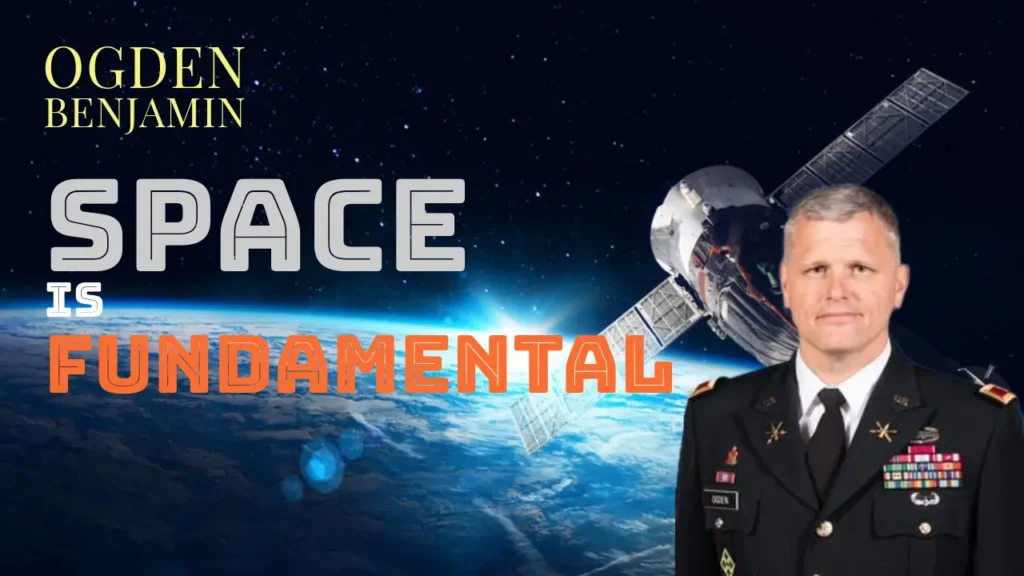
BENJAMIN OGDEN
Professor of Strategic Space Studies, NPEC Space Policy Fellowship Alumnus, MIT Lincoln Labs Defense Technology Seminar Alumnus
The SpaceInfo Club had the honor to ask Mr Ogden some questions about his current job as Professor of Strategic Space Studies as well as his long path in the U.S. Army giving us a unique view on the importance of Space nowadays.
Can you share insights from your 27 years of experience in the US Army, particularly focusing on how military strategies have evolved over the years, especially in the context of space studies?
Let me begin by saying that the views expressed in this interview are mine alone and do not necessarily reflect those of the U.S. Army War College, U.S. Army, or Department of Defense. To your question, so much has changed pertaining to how the U.S. military conducts operations using capabilities across all domains. When I entered the service, we still used the Cold War-era doctrine known as Air-Land Battle, which was the first strategy to synchronize forces from the air, land, and sea to achieve military objectives in large scale operations. After 9/11, however, our military strategy changed to support localized counterinsurgency operations in the Middle East but has since evolved, once again, to Multi-Domain Operations or MDO. Think of MDO as Air-Land Battle 2.0 because it now includes critical Cyber and Space capabilities into global strategies to help create advantages that achieve objectives. While space was present early in my career, it has grown to become a vital pillar in our current doctrine that sustains the U.S.’s way of life and way of war.
Notice Title
Everyday’s Example: the GPS (Global Positioning System) satellite constellation is a network of satellites orbiting Earth, providing location and time information to users anywhere on or near the planet’s surface. Developed and maintained by the United States government, GPS comprises multiple satellites arranged in orbits about 20,000 kilometers above Earth. The constellation consists of around 30 active satellites, including spares, strategically positioned to ensure global coverage.
Each GPS satellite orbits Earth twice a day in a precise orbit and transmits signals that allow GPS receivers to calculate their exact location, speed, and time. These signals are utilized in various applications, including navigation for vehicles, aircraft, ships, and smartphones, as well as in scientific research, surveying, and military operations.
Geostationary satellites, on the other hand, are positioned much farther from Earth, approximately 35,786 kilometers above the equator. Unlike GPS satellites, which move in orbits around Earth, geostationary satellites are fixed relative to a specific point on Earth’s surface. This positioning allows them to appear stationary from Earth’s perspective, as they orbit at the same rate as the Earth’s rotation. Geostationary satellites are commonly used for telecommunications, weather monitoring, broadcasting, and other applications requiring continuous coverage over a specific region.
As a professor of strategic space studies, how do you see the role of space in modern warfare, and what are the key challenges and opportunities it presents for military strategists?
The role of space in modern warfare is vital. In fact, I would say that space is the primary enabler that makes modern warfare, “modern”. Without assured space capabilities, the U.S. military and its allies would lose informational dominance and revert to the challenges of industrial age armies. Capabilities like GPS, satellite imagery, and communications allow modern forces to operate anywhere on Earth with the precision and speed needed to decisively win in conflict with the least amount of destruction or civilian casualties. Without space, strategists would have to develop strategies that account for things like slower tempo, command and control limitations, dependence upon line-of-sight communications, and inaccurate munitions – all of which have greater associated risks.
How does your background in the military inform your teaching at the US Army War College and the Johns Hopkins School of Advanced International Studies? Are there specific lessons from your military career that you find particularly valuable in an academic setting?
My career has had a “mud to space” path that gives me a unique and relevant perspective to teach at these institutions. My original specialty was Army Air & Missile Defense (AMD) where I was placed in support of army combat units, giving me a great appreciation of how ground forces operate and how to lead people. Later, my missile defense jobs required me to work strictly with the U.S. Air Force, giving me a glimpse into air domain operations and how it differed from land operations. Finally, I was assigned to U.S. Army Space & Missile Defense command, expanding my reach into space operations and how it related to terrestrial conflict and national strategy. These three experiential trends converged as I became a faculty member at the U.S. Army War College and began a journey to teach other senior officers and students my knowledge and experiences.
Space is becoming an increasingly contested domain. What do you believe are the most pressing issues and potential conflicts related to space security, and how can nations address these challenges collaboratively?
With the democratization of space and new actors pursuing their interests there, some emerging activities and technologies are worrisome. Two issues are the most pressing: increasing Space Situational Awareness (SSA) and establishing norms of behavior. SSA is the foundational element to all space operations. If we can’t collectively see what’s happening in space, then we won’t be able to solve disputes when they arise or deter participants from using technology for nefarious purposes. Also, space uniquely lacks agreed upon rules or norms meant to standardize operations and prevent miscalculation. Things like right-of-way or safety zone practices are essential ground rules meant to avoid escalatory behavior and they are ambiguous in space. Nations can only address these collaboratively through either bilateral discussions or multilateral institutions such as the UN, and those efforts aren’t keeping up with the growing activity.
Notice Title
Space Situational Awareness (SSA) refers to the monitoring, understanding, and prediction of objects and activities in space, particularly in Earth’s orbit. It involves tracking satellites, space debris, and other space objects, assessing their trajectories, and identifying potential collisions or threats to space assets.
SSA serves several purposes:
– Space Traffic Management: With an increasing number of satellites and space missions, SSA helps manage space traffic to prevent collisions and minimize the risk of accidents or interference between space objects.
– Space Debris Mitigation: Space debris, such as defunct satellites and fragments from previous space missions, poses a risk to operational satellites and spacecraft. SSA plays a crucial role in monitoring space debris and assessing the risk it poses to active missions.
– Protecting Space Assets: Understanding the space environment and potential threats allows operators to take proactive measures to protect their satellites and space assets from collisions, electromagnetic interference, or other hazards.
– Space Weather Monitoring: SSA also encompasses monitoring space weather phenomena, such as solar flares and geomagnetic storms, which can affect satellite operations and infrastructure on Earth.
SSA is typically conducted by government agencies, such as NASA and the U.S. Space Force, as well as international organizations and commercial entities involved in space operations. It relies on a network of ground-based telescopes, radar systems, and satellite tracking facilities to collect data on objects in space and analyze their behavior and characteristics.
In your role as an adjunct professor, how do you engage students in discussions about the intersection of strategic space studies and international relations? Are there specific case studies or examples that you find particularly effective in illustrating key concepts?
I try to emphasize that space is not a completely unique or foreign domain. The physical environment and physics are different, but most academic disciplines we study also apply to activity in space. Although sovereignty doesn’t exist in space by design, international relations remain relevant because space is a global realm of international activity that ties back to national interests on Earth. I usually point to the great power competition unfolding in space between China and the United States. China favors a realist approach by conducting its various space activities in an isolated fashion with a sole focus on its own national objectives without regard for the rest of the space community. The U.S., on the other hand, assumes a liberalist view by adopting strict policies and alliances that promote a common set of norms and values within the international system and structure. What has yet to be observed is which IR theory carries the most weight in space because we’ve only experienced competition, not conflict, there.
Embracing the Cosmos: World Space Week 2025 & SpaceInfo Club’s Mission
Leicester Scientists Bring Space Exploration to London as Cutting-Edge Telescope Joins SMILE Mission
A Cosmic Accident Solves Jupiter & Saturn’s Silicon Mystery
DWARF 3 vs DWARF 2 Smart Telescope: Is the Upgrade Worth It?
Argotec’s CURIE: The Electric Heart Driving Small Satellites to the Edge of the Unknown
Argotec and UniBap Forge Strategic Partnership to Power Next-Generation Satellite Missions
The development of space technologies has accelerated in recent years. How do you see these advancements impacting military doctrines and strategies, and what implications do they have for global security?
From my perspective, the recent advances in space technologies impact global security in two ways. First, most advances have come from the commercial space sector, so nations are struggling to determine if and how to utilize them for unintended purposes. The trend seems to be that nations intend to use commercial technology for national security purposes, so the line between private and military actors will continue to blur, causing legal and operational confusion in times of conflict. We saw this dilemma emerge when Starlink satellites directly supported Ukrainian military operations at the outset of the Russia-Ukraine war. Second, emerging technology will also allow more movement and maneuver on orbit that did not exist in the past. The U.S. Space Force calls this Dynamic Space Operations, and it will require space doctrine and strategies to incorporate normal military principles and functions that are present in the traditional domains into space operations.
As technology continues to advance, how do you see the role of space assets evolving in future military operations, and what considerations should military planners keep in mind when incorporating space capabilities into their strategies?
I see the role of space assets in the future changing from strictly enabling and enhancing warfare on Earth – as it has been in the past – to securing space itself. Now that the U.S. Department of Defense has officially named space a geographic warfighting domain, the military will need to conduct operations that support ongoing activity within space. This means that military planners may have to consider ways to support space from Earth in addition to supporting Earth from space. This will involve a change in thinking for strategists more familiar with conducting traditional operations, but continued integration of U.S. Space Command and the U.S. Space Force into global operations will assist in normalizing these evolving concepts.
Given your expertise in strategic space studies, what recommendations would you make for policymakers in terms of shaping national and international policies to ensure the responsible and secure use of space?
The U.S. is taking the appropriate action right now to develop international norms of behavior that will make space activity sustainable for the future. The U.S. continues to press other nations to adopt reasonable practices through the U.N. Open Ended Working Group (OEWG) as well as the Artemis Accords. One area that policymakers could revisit is how NASA interacts directly with China, especially since NASA has always been an effective tool for U.S. diplomacy. However, a decade-old U.S. law, commonly called the Wolf Amendment, states that NASA cannot conduct bilateral cooperation with its Chinese counterpart without first getting approval from Congress and national law enforcement agencies. This causes some hesitancy to communicate at a time when some level of communication between competing space powers is essential for overall security and stability in space.
In your opinion, what skills and knowledge are essential for the next generation of military and strategic leaders, particularly in the context of the evolving role of space in national security?
I think the skills and attributes we cultivate at the U.S. Army War College are the most essential, since our mission is to develop strategic leaders who will address the most complex national security challenges facing the United States. Skills such as communicating, negotiating, cultural awareness, critical and creative thinking, ethical leadership, multi-domain familiarity, and intellectual curiosity represent a few of the most relevant competencies that will assist leaders in integrating the complexities of space into national security strategies. Space is literally and figuratively distant, so leaders who can envision its value as a key part of global interconnectedness will thrive and make a difference.
Could you discuss any ongoing research or projects you are currently involved in that focus on the intersection of military strategy and space studies?
In recent months, I have collaborated with a colleague to study how security of the polar regions has similarities to security in space. The international treaty structures for space and Antarctica share a common origin while the harsh physical environments in these regions present similar challenges as nations begin to increase presence and operations there. Each of these regions has tremendous scientific value to them as well, which adds an element of required cooperation between participants, further complicating policy decisions. There is much to learn by comparing the strategic competition and activity unfolding in these regions.





